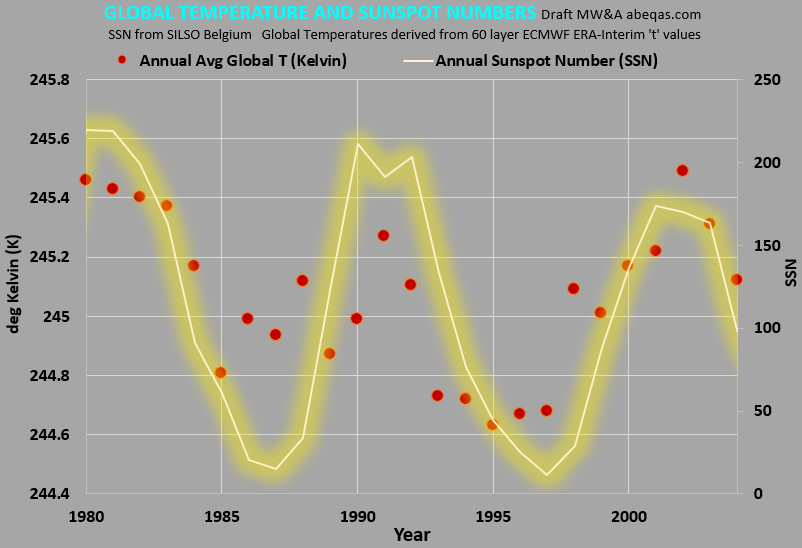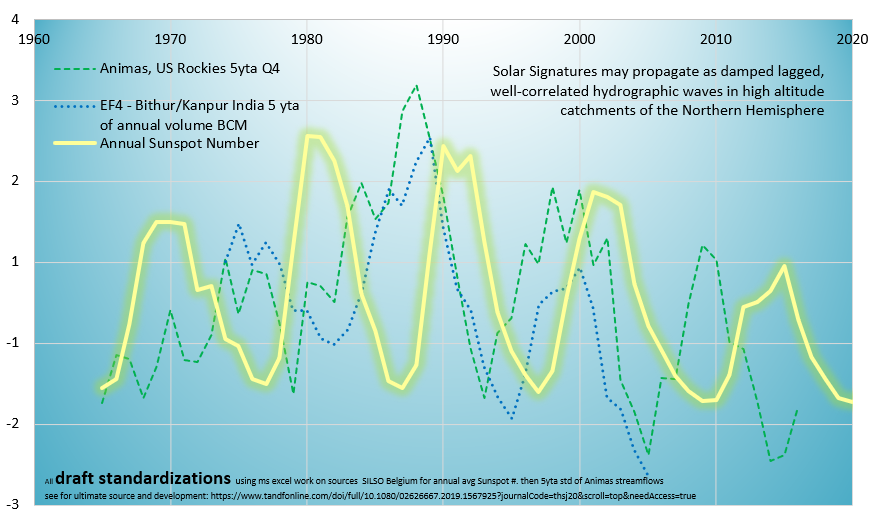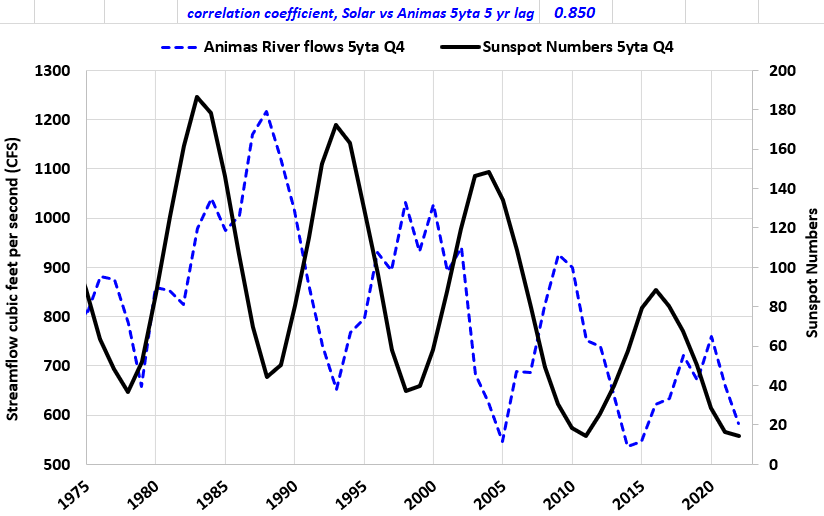The featured image is an updated time series of sunspot numbers vs. streamflows of the Animas River at Farmington, NM. The Animas River is an important tributary of the greater Colorado River Basin. See [1] for an earlier exploration of these connections between rivers and the Sun, published in 2019. The lagged connections appear to remain as strong as ever since that time, with a correlation coefficient (CC) equal to 0.85. This may be the most significant correlation between solar cycles and hydrologic patterns ever discovered. It’s also likely the most neglected correlation. The paper has never been cited, other than by a later paper I coauthored and also an invited poster presentation I gave last week at the NASA Jet Propulsion Laboratory.
The connection between Solar and the Animas River for this time period covered is much deeper than a high correlation. There is also an impressive “goodness of fit” as detailed in [1] Table 5. and Figure 9. The Chi Squared and Kolmogorov Smirnov tests were applied to study this fit. And the connections are much deeper still than some fit tests. The references below help to develop the physical connections between the Sun and the long – term trend of the featured rivers, from around the world.
Again, this is a correlation based on a lag of 5 years between the solar series and the Animas series. Everything follows closely. The trends match. The number of cycles match. The peaks of each series roughly match. The minima of each series match. Consider in comparison, that time series representations of greenhouse gases don’t even express such oscillations. And yet greenhouse gases are attributed to force droughts, while solar irradiance is not.
Those who are ready to explore this rabbit hole deeper still might find this next connection puzzling and yet reinforcing:

Note that the central Sunspot Number peak two-pointed crown bears a striking resemblance to the 5yta Animas streamflow 7 years later. And so the propagation of the solar signature from a refined time scale (1 yr) towards a delayed HYDROLOGIC signature within the Southern Rockies, 7 YEARS LATER, appear to be most convincing to me at least. The connections of Solar to Temperature are also something shown in this graph and a previous post. I am grateful to have stumbled upon both of these connections and I am also working much of that into manuscripts with others.
I’m also a big supporter of objective transparent peer review. I plan some posts about peer review / fear review sometime because I have all kinds of thoughts and experiences, which reinforce my belief that peer reviews in academic journals should be objective and transparent. They are not currently transparent, because reviewers are typically anonymous. That’s a significant difference from peer reviews in industry and research. In those communities, it is regarded as critical for reviews to be objective and transparent, at least in-house. Otherwise the products may fail.
And if a product fails, both the authors and the reviewers can be held to account. Failure in academia is dictated by other concerns, most unfortunately.
In the Animas case, I was under the impression when I published [1], that other research publications would at least be obligated to cite this paper and explain their way around it, as they continued to assert that droughts in the Western US are caused by greenhouse gases. I know that in writing this paper, I was careful to cite prior art and explain how my explorations and innovations were different. I know it sounds odd, perhaps unbelievable, but a reviewer or editor of that paper instructed me to leave out any comparisons of my work to studies of western drought that favored greenhouse gas causality. Accordingly, it seems that no climate researcher will cite my work, and I will not be permitted to cite theirs. That’s not how the scientific method is supposed to play out.

In any case, I’m glad that you can visit this site and give some thought to these solar climate connections. Perhaps eventually awareness will expand enough that Solar will have to be addressed candidly and fully throughout all climate science practices. One doesn’t have to be a climate scientist to recognize the importance of these time series demonstrations, based on actual non-controversial observations that are not dependent upon models or satellite data.
draft, contains opinions. likely to be expanded over the next month or so.
Sources for featured image: SILSO, Belgium for Solar time series. USGS for Animas River time series.
References:
[1] Wallace, M.G., 2019. Application of lagged correlations between solar cycles and hydrosphere components towards sub-decadal forecasts of streamflows in the Western US. Hydrological Sciences Journal Volume 64 Issue 2. doi: 10.1080/02626667.2019.
[2] Wallace, M.G. 2022. Meridional Explorations of Water Vapor, Ozone, and Carbon Dioxide via Satellite Resources. Invited presentation for NASA AIRS Sounder Science Team meeting (10-12, May 2022) NASA Jet Propulsion Laboratory (JPL), Pasadena California.
 26556total visits,3visits today
26556total visits,3visits today
